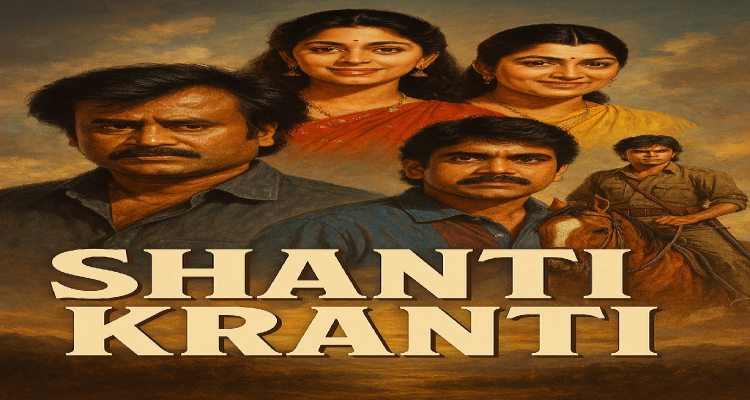India’s Costliest Film That Bankrupted Its Maker
India’s most expensive film in 1991, Shanti Kranti, featured superstars Rajinikanth, Nagarjuna, and Juhi Chawla—but bombed spectacularly, pushing its creator into bankruptcy. Discover how this pan-India dream turned into a financial nightmare.
India’s Costliest Film That Bankrupted Its Maker
How a 1991 pan-India dream project spiraled into the biggest box office disaster of its time
In the glitzy world of Indian cinema, few tales are as dramatic as the story behind Shanti Kranti. Touted as India’s most ambitious film project of its time, it boasted a dream team of superstars, a record-breaking budget, and a vision to unite audiences across linguistic boundaries. Yet, despite its grandeur, it stumbled hard—earning less than it cost to make and leaving its creator in financial ruin.
A Pan-India Vision Before the Term Existed
Back in 1988, long before the term “pan-India” became Bollywood’s favorite buzzword, Kannada superstar and filmmaker V. Ravichandran set out to create a cinematic spectacle that would resonate with audiences across India. He wasn’t just directing Shanti Kranti—he was writing, producing, and starring in it.
The strategy was unprecedented: simultaneously shoot the film in four languages—Kannada, Tamil, Telugu, and Hindi—with a different leading man in each version. Ravichandran played the lead in Kannada, Telugu star Nagarjuna headlined the Telugu edition, and superstar Rajinikanth took center stage in both the Tamil and Hindi versions. Actresses Juhi Chawla, Khushbu, and veteran actor Anant Nag rounded out the cast, appearing in all four versions.
At ₹10 crore, the budget shattered the record previously held by Ajooba (₹8 crore), positioning Shanti Kranti as India’s most expensive film to date.
The Box Office Bombshell No One Saw Coming
Despite its star-studded lineup and multilingual release, Shanti Kranti failed to generate excitement at the box office. Released in September 1991, it opened to lukewarm audiences in Kannada and Telugu, with the Tamil and Hindi versions dropping two weeks later—and faring no better.
The film’s earnings across all four versions totaled just ₹8 crore, falling short of even recovering the production costs, let alone marketing expenses. It was a stark reminder that even the biggest stars can’t guarantee a film’s success if the storytelling doesn’t strike a chord with audiences.
Industry analysts at the time pointed to the film’s disjointed narrative, inconsistent direction across languages, and over-reliance on visual effects that, though ambitious, lacked finesse compared to Hollywood standards. Audiences were left unimpressed, and the film quietly faded from theaters.
Ravichandran’s Fall—and Reinvention
For Ravichandran, the failure wasn’t just cinematic—it was deeply personal. He had invested his savings and even borrowed a 50-acre plot to film the elaborate climax sequence. Lavish sets, costly VFX, and a crew stretched across four states compounded the expenses. In interviews years later, Ravichandran admitted the losses totaled more than ₹10 crore—an astronomical sum at the time.
The financial collapse forced him to pivot his career. He turned to remakes of successful Tamil and Telugu films—often dubbed “B-grade” by critics—to claw his way back into the industry. Though those films didn’t enjoy the prestige of Shanti Kranti, they helped him rebuild and remain a presence in Kannada cinema throughout the ’90s.
A Cautionary Tale for Dreamers
Shanti Kranti may not be remembered for its cinematic brilliance, but it serves as a case study in the risks of overreaching without market alignment. While today’s film industry is more equipped to handle pan-India productions—with targeted marketing, digital platforms, and audience analytics—in 1991, Ravichandran was a man far ahead of his time, working without a net.
The film’s failure underscored the importance of cohesive storytelling and cultural nuance in multilingual projects. Modern successes like Baahubali and RRR learned from such missteps, carefully tailoring content while respecting linguistic and regional differences.
Closing Thoughts: When Ambition Isn’t Enough
Cinema has always been a medium where dreams come alive—but sometimes, the pursuit of a dream can be financially devastating. Ravichandran’s Shanti Kranti reminds us that bold visions need more than just big budgets and star power; they demand thoughtful execution, strong narratives, and a deep understanding of diverse audiences.
For today’s filmmakers navigating India’s multilingual terrain, the rise and fall of Shanti Kranti remains a powerful lesson in both ambition and restraint.
Disclaimer:
This article is a reimagined narrative based on publicly available historical data and media reports. It is intended for informational and educational purposes, aiming to present the story in a professional and engaging manner.
source : Hindustan Times











